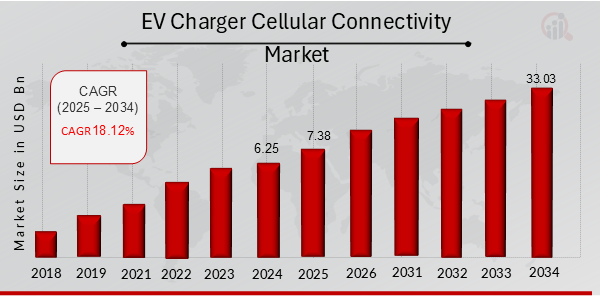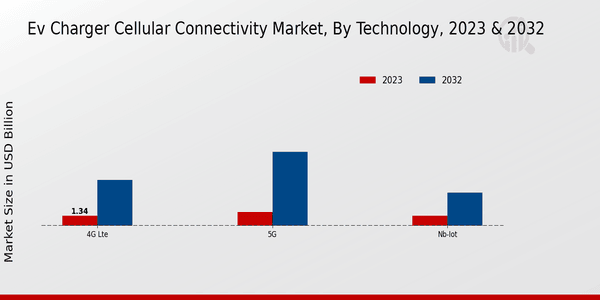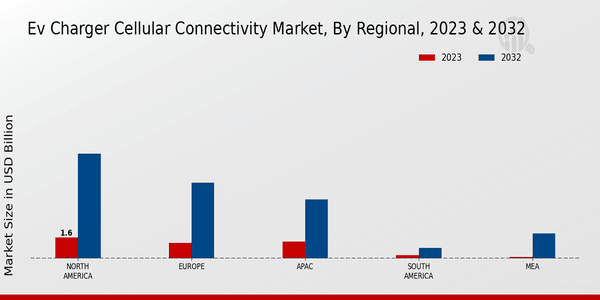EV Charger Cellular Connectivity Market Overview:
As per MRFR analysis, the EV Charger Cellular Connectivity Market Size was estimated at 6.25 (USD Billion) in 2024. The EV Charger Cellular Connectivity Market Industry is expected to grow from 7.38 (USD Billion) in 2025 to 33.03 (USD Billion) till 2034, at a CAGR (growth rate) is expected to be around 18.12% during the forecast period (2025 - 2034).
Key EV Charger Cellular Connectivity Market Trends Highlighted
The EV Charger Cellular Connectivity Market is witnessing significant growth driven by the increasing adoption of electric vehicles, which is largely fueled by the need for sustainable transportation solutions. Governments and private sectors are investing in EV infrastructure to reduce emissions and promote green energy usage. This escalation in electric vehicle sales has created a demand for efficient and robust charging solutions that can operate with reliable cellular connectivity. Improved network technologies, such as 5G, are enhancing the communication between EV chargers and central systems, enabling better management and monitoring of charging operations.
There are numerous opportunities in the market for companies to explore, especially in developing regions where EV infrastructure is still emerging. Offering tailored connectivity solutions that accommodate various regional requirements can provide a competitive edge to market players. Partnerships between telecommunications companies and EV manufacturers can lead to innovative solutions that enhance user experience. Moreover, advancements in IoT and smart grid technologies can be leveraged to offer added functionalities such as remote diagnostics, predictive maintenance, and real-time data sharing, further driving market growth. Recent trends highlight an increased focus on user-friendly charging experiences, such as the integration of mobile applications that provide real-time charger availability and location services.
Additionally, there is a shift towards open standards and interoperability, allowing different EV models and charging stations to function seamlessly together. As consumers become more tech-savvy, features like contactless payments and data analytics for energy consumption are becoming essential. These trends are shaping how EV charging systems are designed and implemented, aiming to create a more connected, efficient, and user-oriented charging ecosystem.

Source: Primary Research, Secondary Research, MRFR Database and Analyst Review
EV Charger Cellular Connectivity Market Drivers
Increasing Adoption of Electric Vehicles
The rapid growth of the electric vehicle (EV) market is a significant driver for the EV Charger Cellular Connectivity Market Industry. As governments worldwide push for a transition to greener transportation options to combat climate change and reduce carbon emissions, the demand for EVs has surged. This increase in EV sales directly correlates with the need for more efficient and robust charging solutions, including cellular connectivity for EV chargers.
Smart EV chargers equipped with cellular connectivity enable real-time communication, monitoring, and management of charging stations, thereby enhancing user experience and operational efficiency. This growing trend not only facilitates the integration of renewable energy sources into the charging process but also helps in optimizing energy consumption patterns. Moreover, advancements in battery technology and charging infrastructure are making electric vehicles more accessible and user-friendly, which further stimulates the growth of the EV Charger Cellular Connectivity Market Industry.
Governments are also incentivizing EV purchases and the development of charging infrastructure through subsidies and grants. The expansion of EV offerings by traditional automakers and startups alike has led to increased consumer confidence and investment in EV technology, propelling the demand for cellular-connected chargers. As this momentum continues, manufacturers will be increasingly inclined to incorporate advanced connectivity features into their charging solutions, solidifying the relationship between EV adoption and the cellular connectivity market.
Technological Advancements in Connectivity Solutions
Rapid advancements in connectivity technologies, such as 5G and IoT, are reshaping the EV Charger Cellular Connectivity Market Industry. These technological improvements enable more efficient data transfer and communication between EVs and charging stations, enhancing user experience. The integration of IoT into charging infrastructure allows for predictive maintenance, optimal energy management, and real-time updates, which can significantly improve the overall efficiency and accessibility of EV charging solutions.As technology continues to evolve, the capabilities of EV charging networks will expand, attracting more users and facilitating wider adoption of EVs.
Government Initiatives and Subsidies
Governments globally are implementing various initiatives and subsidy programs to encourage the adoption of electric vehicles and the development of supporting infrastructure. These incentives can range from tax breaks for EV buyers to financial support for companies building charging infrastructure. As a result, the demand for EV charging solutions and cellular connectivity is steadily increasing as part of the EV Charger Cellular Connectivity Market Industry.Such government backing not only helps to lower the overall cost of ownership for EV users but also plays a vital role in accelerating the necessary infrastructure to accommodate the anticipated growth of the electric vehicle market.
EV Charger Cellular Connectivity Market Segment Insights:
EV Charger Cellular Connectivity Market Technology Insights
The EV Charger Cellular Connectivity Market is rapidly evolving, with a significant valuation of 4.47 USD Billion in 2023 and projected to grow substantially by 2032. This growth is driven by increasing demand for electric vehicles and the necessary infrastructure to support them. The Technology segment plays a crucial role in this market, particularly with sub-segments such as 4G LTE, 5G, and NB-IoT showing distinctive impact and potential.
The 4G LTE segment, valued at 1.34 USD Billion in 2023 and expected to reach 5.98 USD Billion by 2032, plays a significant role in enabling reliable communication for existing EV charger networks, reflecting its majority holding in connectivity solutions.It serves as a robust backbone for real-time data transfer and operational efficiency. Meanwhile, the 5G segment, with a valuation of 1.78 USD Billion in 2023, is anticipated to surge to 9.67 USD Billion by 2032, showcasing its potential to transform the EV charging landscape by offering ultra-low latency and enhanced speed, thus supporting more advanced charging solutions and smart grid technologies. The increasing deployment of 5G infrastructure is set to enhance user experience by enabling faster charging times and improved reliability. NB-IoT, valued at 1.35 USD Billion in 2023 and projected to grow to 4.35 USD Billion by 2032, connects devices with lower data transmission requirements, reducing operational costs and energy consumption for networked EV chargers.
This technology is particularly important for smart cities and isolated locations where traditional connectivity may be limited. Overall, while all segments contribute significantly to the EV Charger Cellular Connectivity Market revenue, 5G shows substantial potential for growth due to its ability to accommodate a broader range of applications, making it a driving force behind market evolution, while 4G LTE and NB-IoT provide foundational support and address specific needs within the industry, showcasing the diverse opportunities and growth drivers within this market.
The market statistics indicate that the continuous advancements in cellular technology will likely lead to enhanced integration of EV charging solutions, further propelling the market's development and adoption. The interplay of these technologies underlines the importance of innovation and infrastructure development in facilitating the shift towards sustainable mobility solutions.

Source: Primary Research, Secondary Research, MRFR Database and Analyst Review
EV Charger Cellular Connectivity Market Charger Type Insights
Key to this market is the Charger Type classification, which plays a critical role in the evolving landscape of electric vehicle charging solutions. The market encompasses various chargers, including AC Chargers, DC Chargers, and Wireless Chargers. Among these, AC Chargers typically dominate due to their widespread availability and suitability for residential use, facilitating convenient overnight charging for electric vehicle owners.
DC Chargers represent a significant segment as well; they offer rapid charging capabilities, making them essential for public charging stations and long-distance travel. Wireless Chargers, although currently a minor player, are gaining attention for their potential to simplify the charging experience and enhance user convenience through advancements in technology. As the EV Charger Cellular Connectivity Market grows, the distinct characteristics of these charger types will be pivotal in shaping market trends, identifying growth drivers, and pointing toward emerging opportunities within the industry.
According to recent EV Charger Cellular Connectivity Market statistics, the market's robust growth is expected to be driven by increased consumer adoption of electric vehicles and infrastructure expansion, which will further bolster market segmentation dynamics.
EV Charger Cellular Connectivity Market Connectivity Type Insights
The EV Charger Cellular Connectivity Market is gaining traction as the demand for electric vehicles continues to rise. Among the various connectivity options, Cellular Connectivity is crucial due to its widespread availability and reliability, enabling the real-time monitoring and management of charging stations. Meanwhile, Wi-Fi Connectivity provides a cost-effective solution for EV owners, allowing easy access to charging data and updates via mobile applications.
Bluetooth Connectivity, though less dominant, enhances local control and streamlined interactions between electric vehicles and chargers, contributing to an improved user experience. The increasing integration of smart technologies in charging infrastructures further drives the demand for diverse connectivity options, promising a robust growth trajectory for the Global EV Charger Cellular Connectivity Market. Market statistics indicate that effective segmentation in this landscape can unlock numerous opportunities to streamline operations, maximize efficiency, and cater to evolving consumer preferences.
EV Charger Cellular Connectivity Market Installation Type Insights
This segment is crucial as it addresses the evolving demand for efficient charging solutions in various settings. Residential installations are gaining traction due to increasing home EV adoption and consumer preference for convenience, while Commercial installations are seeing significant growth as businesses strive to enhance their sustainability initiatives.
Public installations dominate the landscape, driven by the need for widespread charging infrastructure to support an increasing number of EVs on the road. This growing momentum not only influences market growth but also presents opportunities for innovative connectivity solutions and services. Overall, the interplay between these types underscores the Global EV Charger Cellular Connectivity Market's capacity to cater to diverse user needs and the significant role it plays in facilitating the transition to electric mobility. Market trends suggest that investment in smart charging technologies is becoming integral across all installation types, bolstering the overall efficiency and user experience.
EV Charger Cellular Connectivity Market Regional Insights
The EV Charger Cellular Connectivity Market is experiencing significant growth in various regions, reflecting rising investments in electric vehicle infrastructure. In 2023, North America leads the market with a valuation of 1.6 USD Billion, expected to grow to 8.0 USD Billion by 2032, showcasing its majority holding in the market. Europe follows closely, valued at 1.2 USD Billion in 2023, projected to rise to 5.8 USD Billion, driven by stringent emissions regulations and an expanding EV ecosystem. The Asia-Pacific (APAC) region, valued at 1.3 USD Billion, is anticipated to reach 4.5 USD Billion, representing a significant growth potential fueled by increasing EV adoption and favorable policies.
South America and the Middle East Africa (MEA) regions hold smaller market shares, with values of 0.25 USD Billion and 0.12 USD Billion in 2023, respectively, but are set to grow to 0.8 USD Billion and 1.9 USD Billion by 2032. The EV Charger Cellular Connectivity Market segmentation highlights that North America and Europe dominate due to their advanced infrastructure and regulatory frameworks, while APAC exhibits high growth potential, positioning itself as an emerging player in the EV market landscape.

Source: Primary Research, Secondary Research, MRFR Database and Analyst Review
EV Charger Cellular Connectivity Market Key Players and Competitive Insights:
The EV Charger Cellular Connectivity Market is rapidly evolving as electric vehicles gain traction worldwide, spurred by the growing focus on sustainability and the reduction of greenhouse gas emissions. This sector is characterized by the introduction of advanced charging technologies that leverage cellular connectivity to enhance the efficiency and reliability of EV charging stations. The demand for seamless integration of charging infrastructure with digital solutions, mapping services, and real-time monitoring is prompting manufacturers to innovate constantly, creating a competitive landscape marked by both traditional automotive companies and technology firms. The market is further influenced by government initiatives to promote electric vehicle adoption and the expansion of charging networks, creating opportunities for new players and established brands alike.
Electrify America has established itself as a significant player in the EV Charger Cellular Connectivity Market with a strong network of charging stations across the United States. One of its key strengths lies in its commitment to providing a reliable and robust charging infrastructure that features state-of-the-art cellular connectivity solutions. This allows users to access real-time data on charging station availability, operational status, and performance metrics via mobile applications. The company's strategic partnerships with various stakeholders, including automotive manufacturers and technology providers, help enhance its market presence.
Electrify America's continued investment in expanding its charger network and improving its technological capabilities positions it well to cater to the growing demand for efficient electric vehicle charging solutions.EVBox also plays a crucial role in the Global EV Charger Cellular Connectivity Market, known for its innovative approach to electric vehicle charging. The company focuses on delivering versatile and scalable charging solutions that integrate seamlessly with existing infrastructure, leveraging cellular connectivity to provide enhanced user experiences. EVBox's strengths are highlighted by its commitment to sustainability, extensive product range, and emphasis on user-friendly interfaces. The company invests significantly in research and development to ensure its products meet the evolving needs of consumers and businesses in various sectors. With a presence in multiple international markets, EVBox is well-positioned to contribute to the growth of cellular-connected EV charging stations worldwide, aligning with trends that prioritize fast, convenient, and reliable charging solutions for electric vehicles.
Key Companies in the EV Charger Cellular Connectivity Market Include:
- Electrify America
- EVBox
- NIO
- Daimler
- Ford
- Tesla
- Blink Charging
- Enel X
- Leviton
- ABB
- Schneider Electric
- Siemens
- Wallbox
- ChargePoint
- Itron
EV Charger Cellular Connectivity Market Industry Developments
The EV Charger Cellular Connectivity Market is experiencing significant developments, notably with major players like Electrify America, EVBox, NIO, and Tesla innovating their charging networks to improve user experience and support the growing demand for electric vehicles. Recent advances in 5G technology are enhancing communication capabilities between EV chargers and vehicles, as companies like ABB and Schneider Electric are integrating smart connectivity solutions.
Furthermore, Blink Charging and ChargePoint are expanding their partnerships with municipalities and businesses, increasing the availability of charging infrastructure. In terms of mergers and acquisitions, there have been notable movements; for instance, Ford has been actively pursuing collaborations to bolster its charging ecosystem. Siemens has also made strategic investments in smart charging technologies to stay competitive in this rapidly evolving market. The market valuation for these companies is on an upward trajectory, driven by the rising adoption of electric vehicles globally, which is encouraging further investment and innovation within the sector. The demand for reliable and efficient charging solutions continues to propel advancements and collaborations among industry leaders.
EV Charger Cellular Connectivity Market Segmentation Insights
-
EV Charger Cellular Connectivity Market Technology Outlook
-
EV Charger Cellular Connectivity Market Charger Type Outlook
- AC Charger
- DC Charger
- Wireless Charger
-
EV Charger Cellular Connectivity Market Connectivity Type Outlook
- Cellular Connectivity
- Wi-Fi Connectivity
- Bluetooth Connectivity
-
EV Charger Cellular Connectivity Market Installation Type Outlook
- Residential
- Commercial
- Public
-
EV Charger Cellular Connectivity Market Regional Outlook
- North America
- Europe
- South America
- Asia Pacific
- Middle East and Africa
| Report Attribute/Metric |
Details |
|
Market Size 2024
|
6.25 (USD Billion)
|
|
Market Size 2025
|
7.38 (USD Billion)
|
|
Market Size 2034
|
33.03 (USD Billion)
|
|
Compound Annual Growth Rate (CAGR)
|
18.12% (2025 - 2034)
|
|
Report Coverage
|
Revenue Forecast, Competitive Landscape, Growth Factors, and Trends
|
|
Base Year
|
2024
|
|
Market Forecast Period
|
2025 - 2034
|
|
Historical Data
|
2019 - 2023
|
| Market Forecast Units |
USD Billion |
| Key Companies Profiled |
Electrify America, EVBox, NIO, Daimler, Ford, Tesla, Blink Charging, Enel X, Leviton, ABB, Schneider Electric, Siemens, Wallbox, ChargePoint, Itron |
| Segments Covered |
Technology, Charger Type, Connectivity Type, Installation Type, Regional |
| Key Market Opportunities |
1. Rising EV adoption rates, 2. Expansion of smart grid technology, 3. Integration with IoT solutions, 4. Government incentives for EV infrastructure, 5. Development of 5G connectivity solutions |
| Key Market Dynamics |
1. Growing EV adoption, 2. Enhanced charging infrastructure, 3. Technological advancements, 4. Government incentives and regulations, 5. Increased consumer awareness |
| Countries Covered |
North America, Europe, APAC, South America, MEA |
Frequently Asked Questions (FAQ) :
The EV Charger Cellular Connectivity Market was expected to be valued at 33.03 USD Billion in 2034.
The EV Charger Cellular Connectivity Market is anticipated to grow at a CAGR of 18.12% from 2025 to 2034.
North America is projected to dominate the market, valued at 8.0 USD Billion in 2032.
The market is valued at 1.6 USD Billion in North America for the year 2023.
The 5G technology segment is expected to reach a value of 9.67 USD Billion in 2032.
Major players include Electrify America, EVBox, NIO, Daimler, Ford, Tesla, and ChargePoint.
The value of NB-IoT technology is expected to be 4.35 USD Billion in 2032.
The market in Europe is predicted to grow to 5.8 USD Billion by 2032.
The market valuation in South America is 0.25 USD Billion for 2023.
Key applications include smart charging solutions and vehicle-to-grid communications, driving significant growth.

















